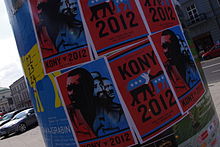Joseph Kony
After the Ugandan Civil War, Kony participated in the subsequent insurgency against president Yoweri Museveni under the Holy Spirit Movement or the Uganda People's Democratic Army before founding the LRA in 1987.
Aiming to create a Christian state based on dominion theology, Kony directed the multi-decade Lord's Resistance Army insurgency.
[8] He enjoyed a good relationship with his siblings, but was quick to retaliate in a dispute, and when confronted, would often resort to physical violence.
[12] The acts committed by the Museveni's NRA, now known as the Uganda People's Defence Force, led to Kony's creation of the LRA.
[13][14][15][16] In 2006, in the Juba peace talks with the LRA rebels, Museveni's government gave permission for local people to return to their villages.
The LRA has had battle confrontations with the government's NRA or UPDF within Uganda and in South Sudan for ten years.
[20] Looking back at the LRA's campaign of violence, The Guardian stated in 2015 that Kony's forces had been responsible for the deaths of over 100,000 and the abduction of at least 60,000 children.
[21][22][23][24][25] The actual number of LRA militia members has varied significantly over the years, reaching as high as 3000 soldiers.
[41] In October 2006, the ICC announced that arrest warrants had been issued for five members of the Lord's Resistance Army for crimes against humanity following a sealed indictment.
On the next day, Ugandan defense minister Amama Mbabazi revealed that the warrants include Kony, his deputy Vincent Otti, and LRA commanders Raska Lukwiya, Okot Odhiambo, and Dominic Ongwen.
"[51] Ugandan political leader Betty Bigombe recalled that Kony and his followers used oil to ward off bullets and evil spirits.
In Uganda's attempt to track down Kony, former LRA combatants have been enlisted to search remote areas of the CAR, Sudan, and the DRC where he was last seen.
[58] In November 2008, U.S. President George W. Bush signed the directive to the United States Africa Command to provide financial and logistical assistance to the Ugandan government during the unsuccessful 2008–2009 Garamba offensive, code-named Operation Lightning Thunder.
[60] In May 2010, U.S. President Barack Obama signed into law the Lord's Resistance Army Disarmament and Northern Uganda Recovery Act,[61] legislation aimed at stopping Kony and the LRA.
On 12 May 2010, a motion to suspend the rules and pass the bill was agreed to by voice vote (two-thirds being in the affirmative) in the House of Representatives.
[65][66] On 3 April 2013, the Obama administration offered rewards of up to US$5 million for information leading to the arrest, transfer, or conviction of Kony, Ongwen, and Odhiambo.
[71] On 23 March 2012, the African Union announced its intentions to "send 5,000 soldiers to join the hunt for rebel leader Joseph Kony" and to "neutralize" him while isolating the scattered LRA groups responsible for 2,600 civilian killings since 2008.
This international task force was said to include soldiers "from Uganda, South Sudan, Central African Republic and Congo, countries where Kony's reign of terror has been felt over the years."
Several weeks after its release, a resolution condemning Kony and supporting US assistance fighting the LRA was introduced in the US Senate, passing several months later.
Ugandan army spokesman Paddy Ankunda stated that the event "puts the LRA in the most vulnerable position" and that it "is only Kony left standing".
[21] In April 2022, DW News reported that a number of LRA members said Kony was hiding in the Darfur region of Sudan.
[83] In April 2024, Kony was reportedly settled in a camp 10 miles from a village named Yemen in the Central African Republic.
In the same month, hearing the news of the surrender of 14 LRA members to the government forces, the Wagner Group attacked Kony's camp, prompting him and his 71 men to flee towards Sudan.

